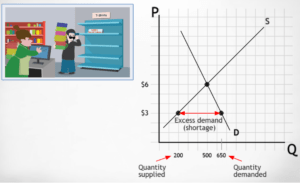Updated 7/12/19
Summary
 Professor Marc Lieberman (Economics) flipped the recitation sections for both of his large lecture courses, Introduction to Microeconomics and Intro to Macroeconomics, eliminating the need for students to purchase textbooks and platform licenses. In addition to developing online modules and animations, Professor Lieberman leveraged NYU Classes to create an online problem solving platform.
Professor Marc Lieberman (Economics) flipped the recitation sections for both of his large lecture courses, Introduction to Microeconomics and Intro to Macroeconomics, eliminating the need for students to purchase textbooks and platform licenses. In addition to developing online modules and animations, Professor Lieberman leveraged NYU Classes to create an online problem solving platform.
Learning objectives
- Provide students with essential review material to clarify points of confusion
- Reduce the variability in instruction by recitation leaders
- Eliminate the need for students to purchase costly textbooks and software
 Professor Marc Lieberman created Open Educational Resources (OER), freely available course content, to solve pedagogical and financial challenges. Common recitation materials lead to all students receiving a similar level of information about key topics. Content can be customized for lectures, and made visually appealing through rich animations created by the NYU IT Media Production Team. No-cost content and platforms save students money (up to $350 per student).
Professor Marc Lieberman created Open Educational Resources (OER), freely available course content, to solve pedagogical and financial challenges. Common recitation materials lead to all students receiving a similar level of information about key topics. Content can be customized for lectures, and made visually appealing through rich animations created by the NYU IT Media Production Team. No-cost content and platforms save students money (up to $350 per student).

Professor Lieberman worked with FAS (in partnership with NYU IT’s TLT Team) to develop similar resources for his Introduction to Macroeconomics course. These were implemented successfully in Fall 2018’s Intro to Macroeconomics course and will be used again in Professor Lieberman’s classes, as well as additional Economics courses running at NYU Florence, in the coming academic year.
Student experience
- Go through online modules prior to lecture
- Attend recitation sections and review material anywhere, anytime
- Complete problem sets
Technology resources
- Custom animations
- Custom interactive modules, for recitation lectures + assessments
- NYU Classes, for custom problem sets
- NYU Stream, to house videos
Outcomes
- Custom content replaced the need to purchase a textbook and interactive software, leading to cost savings of up to $350 per student.
- Standardized instruction across recitation sections
- Ability for students to review material anywhere, anytime
- Similar project completed for Introduction to Macroeconomics in Fall 2018
- Example module: ‘How Banks Get in Trouble’ – Click to view module


